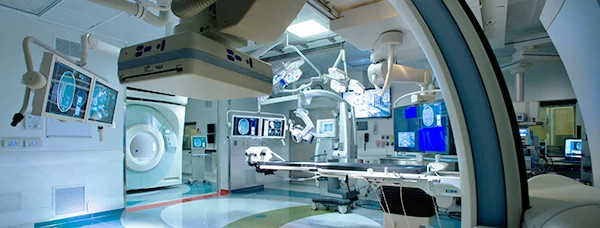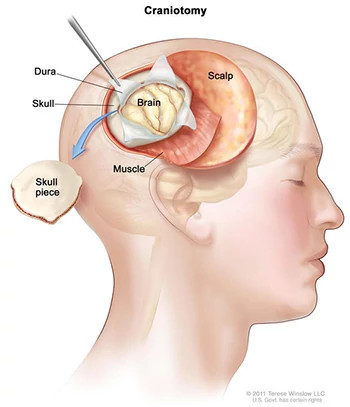Our Treatment Approach
The treatment of all brain tumors is determined on a case-by-case basis. At Dana-Farber Brigham Cancer Center, we believe that you and your family are key members of the care team, and that while we understand your illness, you understand your own body. We work with you and your family to develop a treatment plan that is right for you.
Treatment options and prognosis depend on the grade and location of the tumor, your general health, and whether or not the tumor can be removed by surgery. If any cancer cells remain after surgery, treatment options and prognosis will depend on whether there are certain changes in the chromosomes and whether the cancer was newly diagnosed or had recurred (come back).
Multidisciplinary Team
Our multidisciplinary approach ensures that you and your family will be provided with all available and appropriate treatment options. Your neuro-oncologists provide you with access to continual care, confidentially, 24 hours a day. Our dedicated nurses and physician assistants will guide you and your family throughout the treatment process.
Treatment Options
There are several treatment options for patients with adult brain and spinal cord tumors. The response to treatment in each individual is unique. Some treatments are based on the standard of care, and some are new approaches through clinical trials to aid in the development of more effective therapies.
Five standard types of treatment can be used:
Watchful Waiting
Watchful waiting is closely monitoring a patient's condition without giving any treatment until signs or symptoms appear or change.
Surgery
In most cases, treatment begins with surgery. While not all brain cancers can be treated with surgery, (depending on the location, size, and shape of the tumor), neurosurgery is often the best approach to the treatment of a brain tumor.
One of the Most Important Steps in Your Brain Tumor Care Is Choosing Where to Have Your Surgery
If you are considering surgery for a brain lesion that may be a tumor, or is the recurrence of a previously removed tumor, our physicians can advise whether surgery and treatment at our hospital may make sense for your situation. Having surgery at Dana-Farber Brigham Cancer Center from the beginning can maximize the amount of tumor available for sequencing and genomic testing, to help determine what options you have later in your care. Our team of specialists coordinates with surgeons and pathologists from their first contact with you, to ensure that valuable opportunities for your treatment are not missed.
AMIGO: Advanced Image-Guided Treatment
Our team has over 30 years of experience in minimally-invasive image-guided therapy. The first intraoperative MRI scanner was invented at Brigham and Women's Hospital, paving the way for the advancement of imaging technology during a surgical procedure. Our expert neurosurgeons use advanced techniques to treat tumors that other treatment centers often consider inoperable or untreatable.
Our Advanced Multimodality Image-Guided Operating (AMIGO) Suite opened in 2012, with over 1,000 surgeries completed to date. The AMIGO Suite is a state-of-the-art medical and surgical research operating suite that is home to advanced imaging equipment and interventional surgical systems that guide the intra-operative removal of brain tumors. Neurosurgeons and neuroradiologists at the Center for Neuro-Oncology may use this equipment to efficiently and precisely guide treatment with imaging before, during, and after a surgical procedure without the patient or medical team ever leaving the operating room.

We perform the following surgical procedures for the treatment of brain tumors:

- Awake craniotomy: In this procedure, an opening is made in the skull and a piece of the skull is removed to expose the brain. You will receive anesthesia and medication to numb your body, but you will remain awake through certain parts of the procedure to ensure that there is no loss of speech or functional motor skills while the tumor is being removed.
- Skull base surgery: The skull base is the bottom portion of the skull that supports the undersurface of the brain and protects many vital structures. This area includes the roof of the eye sockets, cheek bone, top of the palate, the deep structures of the ear canals, and the bottom portion of the skull behind the head. The skull base contains cranial nerves and multiple arteries that control complex senses, including hearing, vision, and balance.
Our skull base surgery team, using the latest imaging technology, can reach all areas of the skull base to treat a wide variety of cranial disorders. Our surgical approaches for skull base disorders allow for faster pathological diagnosis, decompression of critical structures, and often, a cure. Our innovative, minimally-invasive surgical techniques – through the side or underneath the skull base – help minimize injury to the brain, resulting in a faster procedure with fewer complications and a more timely recovery.
Our approaches include:
- Expanded endonasal endoscopic approaches (EEA): Minimally-invasive procedures that use an endoscope to remove tumors through the nose.
- Anterior craniofacial surgery: The tumor is removed through the front of the skull base (near the hairline).
- Posterior skull base surgery: The tumor is removed through the back or the side of the skull base.
- Skull base radiosurgery: Uses targeted radiation to reduce a tumor.
- Vascular decompression: Treats trigeminal neuralgia or hemifacial spasm.
Even if the neurosurgeon removes all the cancer that can be seen at the time of the surgery, some patients may be given chemotherapy or radiation therapy after surgery to eliminate any remaining cancer cells and lower the risk that the cancer will return. Treatment given after the surgery is called adjuvant therapy.
Radiation Therapy
Radiation therapy is a cancer treatment that uses high-energy X-rays or other types of radiation to eradicate cancer cells or keep them from growing. The method of radiation therapy depends on the type of tumor and its location in the brain or spinal cord. Our radiation oncologists are experts in radiation techniques; if radiation therapy is indicated for your specific brain tumor, they will discuss the neuro-cognitive effects of radiation therapy with you and your family.
Our radiation and medical oncologists work together to approach radiation therapy as a treatment option. We are committed to providing the safest approaches to radiation and are careful in adopting new treatment technologies. At our Center, radiation therapy is moving away from whole-brain radiation as a standard, and whenever possible, toward techniques that target specific areas of concern in the brain without harming the surrounding healthy tissue.
We often use the following radiation therapy approaches, which cause less damage to the healthy tissue surrounding the tumor:
- 3-dimensional conformal radiation therapy: A procedure that uses a computer to create a three-dimensional (3-D) picture of the brain or spinal cord tumor. This allows doctors to give the highest possible dose of radiation to the tumor, with the least possible damage to normal tissue. This type of radiation therapy is also called three-dimensional radiation therapy, or 3D-CRT.
- Intensity-modulated radiation therapy (IMRT): A type of 3-D radiation therapy that uses a computer to make pictures of the size and shape of the brain or spinal cord tumor. Thin beams of radiation of different intensities are aimed at the tumor from many angles. This type of radiation therapy causes less damage to healthy tissue near the tumor.
- Stereotactic radiosurgery (SRS): A procedure that uses radiation and computer targeting to direct focused radiation to specific targets in the brain that may be difficult to reach through conventional neurosurgery. This minimizes injury to surrounding structures that are not affected by the tumor. The procedure is performed under local sedation, with patients fitted with a face mask to guide targeting; neither a head frame nor a surgical incision is needed.
At Dana-Farber Brigham Cancer Center, we are moving towards the implementation of a smaller, more comfortable face mask for patients and reducing the time it takes to complete the treatment. Patients who receive SRS usually return home the same day.
- Stereotactic radiotherapy: A radiation treatment that is used in some instances for larger brain tumors and is divided, or fractionated, over several days.
Chemotherapy and Targeted Therapy
At the Center for Neuro-Oncology, precision cancer medicine helps us determine which form of chemotherapy is best for you. We analyze the genetic profile of your individual tumor type and may recommend a combination of therapies for optimal results.
Chemotherapy is a cancer treatment that uses drugs to stop the growth of cancer cells, by either eliminating the cells or stopping them from dividing. The way chemotherapy is given depends on the type of tumor and where it is located:
- In systemic chemotherapy, the chemotherapy agents are given intravenously and attack cancer cells throughout the body.
- In regional chemotherapy, cancer-fighting agents are injected into the brain or cerebrospinal fluid, where they target cancer cells locally. Because of the brain's natural blood-brain barrier (BBB), not all drugs are able to pass through and attack cancer cells.
Learn more about targeted therapies for brain tumors.
Immunotherapy
Our clinical experts at the Center for Neuro-Oncology are constantly investigating promising new therapy options for patients with all types of brain cancers.
One promising new area is immunotherapy, which harnesses the power of the body's immune system to detect and combat tumors. Where targeted chemotherapy drugs disable proteins that cancer cells need to grow, immunotherapy drugs stimulate the patient's own immune system to recognize and kill cancer cells.
Monoclonal antibody therapy is often made from an individual patient's tumor cells, or parts of them, which are processed in the laboratory and returned to the patient to stimulate a strong immune response. This unique approach combines immunotherapy with precision cancer medicine.
At the Center for Neuro-Oncology, we have a tremendous array of immunotherapy clinical trials – including vaccines, novel tumor-targeting therapeutics, and anti-angiogenic therapies in recurrent glioblastoma.
Learn more about immunotherapies for brain tumors.